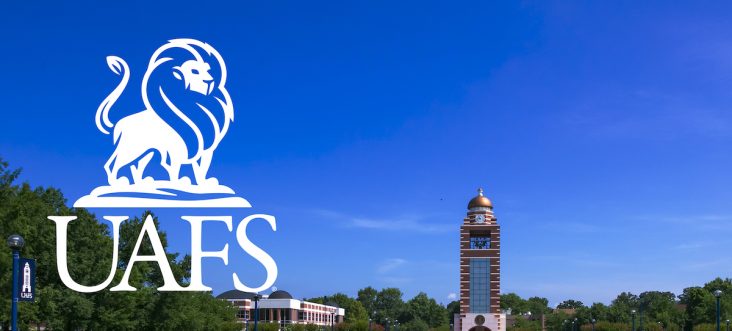New strategic plan, ‘institutional commitments’ for UAFS
by May 30, 2023 3:11 pm 1,072 views

The University of Arkansas at Fort Smith has a new strategic plan that redefines its mission, vision and institutional commitments as it looks toward the next five years. The University of Arkansas Board of Trustees recently approved the Strategic Plan for 2023-2028.
“This is a significant milestone in our university’s history, and it would not have been possible without your dedicated participation in the development of this plan,” Dr. Terisa Riley, UAFS chancellor, wrote in an email to students and staff Thursday (May 25). “Through focus groups, committee revisions, and open forum discussions, your collective efforts have helped shape a strategy that truly reflects our shared vision for UAFS.”
When Riley discussed the process for creating the new strategic plan with the UAFS Board of Visitors in December, she said the new plan would ultimately focus on how to educate more people. She said the key is how UAFS gets students the credentials that they need in order to be career ready and able to help, inform and change the communities where they live.
The new UAFS mission is: UAFS empowers the social mobility of its students and the economic growth of the River Valley through exceptional educational opportunities and robust community partnerships. UAFS Provost Dr. Shadow Robinson said the focus on social mobility reflects a broad commitment of delivering extraordinary value to students.
“Social mobility is frequently measured by comparing how economic income and stability change between generations,” Robinson said. “To achieve this aspect of our mission, our University must not only be committed to offering our students exceptional educational opportunities that lead to those positive career outcomes but also to support those students on every step of their educational journey from the moment they walk onto our campus until they walk across our stage at graduation so that they will be prepared to take full advantage of the career pathways now open to them.”

But even that does not fully capture the call to action in empowering social mobility, he said. About 34% of UAFS students have any form of academic loan, university records show.
“We understand well the long-term impact that student debt can have on the economic trajectory of a young adult, so to maximize the opportunities for our students, we must also aim to reduce, if not eliminate the amount of student debt our graduates have as they begin their careers,” Robinson said.
The university’s new vision is: Through dynamic academic programs, innovative research opportunities, and transformational centers of intellectual and economic development, UAFS will advance its community and become an institution renowned for educating and inspiring the ambitious students who call it home.
Robinson said as a regional public University, UAFS also must serve the public needs in the region.
“We know those needs will change at the same speed, if not faster, than our community changes. To know and meet those needs requires a University deeply connected to its home community and engaged as collaborative partners with every aspect of it,” Robinson said.
The relationship UAFS has with the larger Fort Smith metro is symbolic, meaning that if the area experiences transformative economic growth, the university will grow with it, and if UAFS is strong, it can be the engine that powers that growth, he said.
The strategic plan the university put into place for 2017-2022 had four strategic initiatives:
• Increase the enrollment, retention, and graduation rates of UAFS students;
• Provide an innovative and holistic educational experience for students with a focus on academic opportunities supporting economic growth and development;
• Increase workplace productivity, collaboration and innovation by fostering and championing professional growth and development for university faculty and staff; and
• Strategically align resources to support university objectives.
Those have changed to the following four new key strategic pillars in the 2023-22 strategic plan.
Student Access, Engagement, and Success: We are dedicated to empowering our students to grow, lead, and succeed.
Teaching and Learning: We strive to cultivate exceptional learning experiences and promote excellence within our community.
Economic Development, Community Engagement, and Industry Partnership: We drive transformational change by forging strong and innovative partnerships across the region.
Institutional Sustainability and Resource Stewardship: We are committed to securing our institution’s long-term stability through responsible practices and policies.
The new strategic plan also has the following four Institutional Commitments.
• Students: We provide a supportive and inclusive learning environment for personal and professional success.
• Community: We serve and strengthen the River Valley through collaborations addressing regional needs.
• Integrity: We uphold honest, transparent, and ethical behavior.
• Innovation: We foster creativity, exploration, and novel solutions.
• Value: We prioritize excellence, efficiency, and continuous improvement to provide premium, affordable education.
A detailed version of the strategic plan, organized around four key strategic pillars, will be available at the university’s website in June.
“With the plan now approved by the Board of Trustees, we will begin developing implementation plans. Over the coming months, each university department will create individualized plans aligned with the four strategic pillars, ensuring that robust strategies, actions, and success metrics are clearly articulated,” Riley said in her email. “Department and divisional leaders will submit annual reports on their progress toward achieving their success metrics, and to foster transparency and accountability, summaries of all annual reports will be presented to university employees and students each year.”
